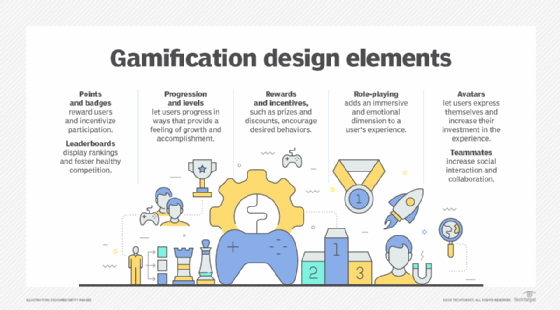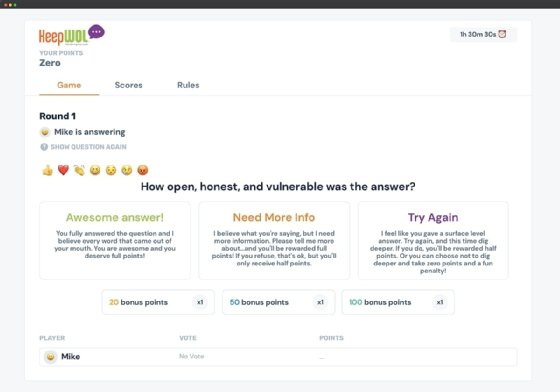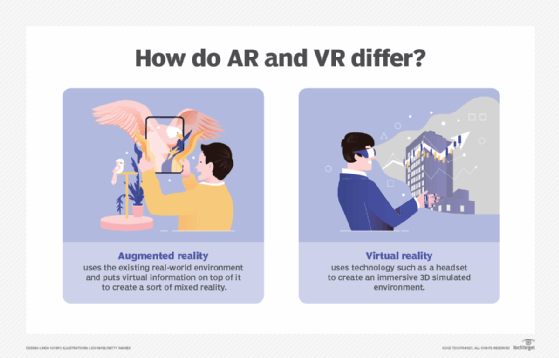What is gamification? How it works and how to use it
Gamification is a strategy that integrates entertaining and immersive gaming elements into nongame contexts to enhance engagement and motivate certain behaviors. It uses game design and mechanics, such as badges, leaderboards, points and rewards, to encourage active participation and make tasks fun and enjoyable.
Gamification is used in various fields, including education, marketing, employee training, health, wellness and customer engagement. It is a valuable strategy that can make dull experiences more engaging for participants. For instance, educational applications might use gamification to make learning more engaging for students, while businesses might use it to improve employee performance, encourage customer loyalty or reward employees and customers. Successful gamification requires an understanding of target audiences, their motivation and the context in which the gamification strategy is applied.
How does gamification work? Game design elements explained
Gamification uses various game contexts and game design elements to create immersive and interactive experiences for users. The following elements are generally included in gamification platforms:
- Points and badges. These are fundamental game mechanics that reward users with achievement and progress. Users earn points when they complete specific actions or reach milestones; they are awarded badges for accomplishments or mastery in a particular area. These visual representations of progress incentivize users to keep engaging with the system.
- Leaderboards. These display the rankings of participants based on their performance and achievements. They create a sense of competition, challenging and motivating users to earn a higher position on the leaderboard. Leaderboards are good for motivating people to improve their skills and reach goals.
- Progression and levels. These let users advance through different stages of the game system as they accomplish tasks or gain points. This visual progress provides a feeling of growth and mastery and encourages continued engagement. Unlocking new levels or accessing additional content creates a sense of anticipation and excitement.
- Rewards and incentives. There are extrinsic motivators to encourage desired behaviors. They can include virtual or real-world rewards, such as discounts, access to exclusive content and prizes. By offering incentives, gamification motivates users to participate and complete tasks as well as increase their overall level of engagement.
- Role-playing. The incorporation of a storyline or narrative makes tasks feel more meaningful. Challenges and quests associated with role-playing create a layer of connection between the user and their character or storyline, adding an emotional dimension to the game experience.
- Avatars. These let users create a visual representation of themselves within the gamified system. They enable users to express their personalities and expand their immersive experience, increasing engagement, ownership and investment in the experience. Avatars are used outside of gamified systems to represent employees in the enterprise.
- Teammates. These provide social interaction that lets users connect, collaborate and compete with others. Features such as social sharing, multiplayer challenges and collaborative activities enhance the sense of community, encourage team collaboration and create a more engaging and enjoyable experience.
- Audible sound. This is a sound-based element that is meant to promote positive reinforcement. Correct actions are rewarded with a satisfying noise, such as a bell sound or some other audible ding. Even small or subtle rewards, like a satisfying noise, can help enhance a sense of satisfaction -- keeping an individual engaged.

Pros and cons of gamification
Gamification offers key benefits in various contexts:
- Increased engagement. Gamification enhances and boosts user engagement by making tasks more active, enjoyable, interactive and rewarding. Gamification efforts have been shown to increase customer engagement in particular.
- Motivation and behavioral change. Game systems drive desired behaviors by providing incentives, positive feedback loops and a sense of progress. In various contexts, they motivate participants, encourage healthy habits and improve learning outcomes.
- Improved learning and retention. Gamification in education makes the learning experience more interactive and immersive, increasing student engagement and knowledge retention. When educational materials incorporate game mechanics, students are more likely to stay focused and retain information.
- Social interaction and collaboration. Gamification is an effective team collaboration tool, fostering social interaction and collaboration through features such as leaderboards, multiplayer challenges and community forums.
- Healthy competition and building of soft skills. Gamification can help foster friendly competition, which can help individuals and teams develop soft skills.
- Data and analytics. Gamification provides valuable user data and data analytics on user behavior, user preference and user performance. Such data can be used to optimize the gaming experience, personalize content and inform decision-making.
- Increased brand loyalty and customer satisfaction. By incorporating gamification into marketing campaigns and loyalty programs, businesses can enhance brand and customer loyalty and satisfaction. Rewards, challenges and personalized experiences create a more enjoyable and memorable customer journey.
- Faster feedback. Gamification enables real-time feedback on performance. If an individual does something wrong, there is often some form of feedback to help correct the user.
- Safe environment to fail. Gamification creates an environment where users can make mistakes and learn from them without real-world risks.
However, while gamification is effective in many contexts, it comes with several drawbacks:
- Lack of intrinsic motivation. Gamification relies heavily on extrinsic motivators, such as rewards and incentives, which can undermine intrinsic motivation and lead to a dependence on external rewards.
- Overemphasis on competition. Leaderboards and competitive elements can create a sense of exclusion and demoralize individuals who might not perform as well as others.
- Superficial engagement. Gamification can result in superficial engagement, where users primarily focus on earning points and rewards rather than truly immersing themselves in the experience.
- Resistance to change. Some individuals resist game-based initiatives, perceiving them as forced or manipulative. To overcome this resistance, it's crucial to communicate the benefits and value of gamification.
- Design and implementation challenges. Effective gamified experiences require careful planning and consideration of user preferences. Gamified systems with poor digital experience can fail to engage users or achieve desired outcomes.
- Cost. Developing and implementing gamified systems can be costly and take longer to design and implement.
- Disingenuous experience. Poorly designed gamification systems resulting in thinly disguised quizzes or tests might feel insincere to the user and can seem like a mandatory task rather than an engaging experience.
- Topic limitations. Some topics might not be appropriate or suitable for gamification.
Use cases and examples of gamification
Gamification has been successfully implemented in different industries and contexts. The following are some notable examples.
Marketing and customer engagement. Companies such as McDonald's, Nike and Starbucks use games to encourage customer engagement and loyalty. Loyalty programs, mobile apps and interactive marketing campaigns often incorporate game mechanics such as point systems, badges and rewards to motivate customers to interact with a brand.
The McDonald's Monopoly game, for example, was a sales promotion run by McDonald's based on the board game Monopoly to encourage repeat purchases by offering a chance to win prizes.
Workplace training and employee engagement. Gamification has proven effective in enhancing workplace training and improving employee engagement.
Companies such as Deloitte and IBM have used gamified training programs to increase knowledge retention, encourage collaboration and motivate employees to complete training modules.

Health and wellness. Health and wellness apps and platforms use gamification to motivate individuals to adopt healthier lifestyles.
Fitbit, MyFitnessPal and similar internet of things apps use game elements to track physical activity, set goals and reward users for achieving milestones. This gamified approach encourages users to stay active and make healthier choices.
Education and e-learning. Game-based learning and e-learning have transformed education, making learning more interactive and even fun. Gamified learning platforms provide immediate feedback, progress tracking and rewards to motivate students.
Online learning platforms, such as Duolingo and Khan Academy, incorporate game elements to engage learners in subjects such as language learning and math.
Productivity and task management. Task management apps, such as Asana and Trello, use gamification to increase productivity and help users stay organized. By incorporating elements like achievements, progress bars and leaderboards, these apps make completing tasks more enjoyable and provide a sense of accomplishment.
Viva Insights, a part of Microsoft Viva, is a task management app that can help users plan for meetings, section off time to focus on work and provide recommendations to improve user productivity. The app gamifies task management by encouraging the completion of tasks and taking breaks, providing badges and tracking progress along the way.
Fundraising and crowdsourcing. Fundraising and crowdsourcing campaigns use gamification techniques to encourage participation and contributions. Gamification elements create a competitive and rewarding environment, encouraging individuals to get involved, collaborate, share ideas and support causes.
The crowdfunding platform Kickstarter uses stretch goals, which can be interpreted as a form of gamification, as additional rewards are unlocked when a project passes its original fundraising goal.
Gamification in the workplace
Gamification strategies can be a powerful tool in the workplace to boost employee engagement, productivity and motivation. The following are some ways to use gamification in the workplace:
- Goal setting. Gamified systems are used to set clear employee goals and reward progress and achievements with points, badges or virtual currency.
- Training and development. Gamified training programs make learning more engaging and interactive. They often include quizzes and leaderboards to motivate employees to complete training modules.
- Collaboration and teamwork. Game systems foster collaboration and healthy competition among employees with team challenges and multiplayer, team-based goals.
- Performance management. Gamified systems are used to track and reward employee performance. Leaderboards showcase top performers and offer incentives for meeting or exceeding targets.
- Recognition and rewards. A gamified rewards and recognition system motivates employees and reinforces desired behaviors. Achievements are recognized with badges, virtual rewards or tangible incentives.
When not to use gamification
Although gamification can significantly improve engagement in some instances, it is not a great fit for every setting. When the subject is sensitive, adding gamification elements will come across as inappropriate at best and offensive at worst.
For example, educating employees about workplace harassment using training software with gamification elements might not be entirely appropriate, as the seriousness of the topic clashes with the lightheartedness that gamification brings.
Not every person will respond in kind with gamification strategies. Some might have too short of an attention span, while the rewards gamification brings might not be enough of a carrot to keep someone motivated and engaged. Others simply might not naturally respond well to gamification elements.
Best practices for implementing gamification
The successful implementation of gamification requires some best practices and guidelines. The following are the most critical:
- Define clear objectives. The goals and objectives of the gamification initiative should be clearly defined. Furthermore, the desired behaviors and outcomes of participation should align with a company's overall business culture and objectives.
- Understand the target audience. The preferences, motivations and needs of the target must be considered when creating and implementing a system. The gamified experience should be adapted to generational marketing factors and tailored to the target audience's interests and expectations.
- Provide meaningful rewards. Rewards in a game system should be valuable to the target audience. Ensure they're aligned with the desired behaviors and provide a sense of accomplishment.
- Design for user experience. The system should have a seamless and intuitive user experience. Game elements must be easy to understand and navigate. Clear instructions and feedback help with this aspect.
- Regularly update and evolve. Keep the gamified experience fresh and engaging by regularly updating content, adding new challenges and introducing new features. This prevents users from becoming bored and disengaged.
History of gamification
Nick Pelling coined the term gamification in 2002. However, the concept of applying game elements to nongame contexts -- such as loyalty programs and customer rewards systems -- has been around for much longer.
The rise of video games in the 1970s and 1980s influenced the early development of gamification. The addictiveness of playing video games and the engagement video gameplay generated sparked interest in applying game elements to other areas. In the 1990s, educational games like Math Blaster and Carmen Sandiego introduced gamification to the classroom. These games aimed to make learning more engaging and interactive.
With the success of early gamification efforts, companies such as Nike and Starbucks began incorporating gamification into their marketing campaigns and loyalty programs in the early 2000s. One example is Nike+, a fitness-tracking gamification campaign that Nike launched in 2006. This campaign ranked friends' fitness scores on social leaderboards, marking the beginning of the widespread adoption of gamification in various industries.
The continued use of smartphones and wearable devices, along with the advent of social media and new mobile apps in the 2010s and 2020s, accelerated the popularity of gamification. Smartphones, for example, enabled gamification to spread to several different areas.
Fitness apps started integrating game elements to challenge their users and keep them motivated to exercise. 2016 saw the release of Pokemon Go, which motivated people of multiple generations to exercise by using the augmented reality (AR) app to explore their surroundings. Education apps like Duolingo gamified language learning by using streaks, rewards and audible check marks to motivate people to continue learning.

Enterprises also began using training software that would gamify the training process. Gamification has continued to evolve and expand with advancements in artificial intelligence, virtual reality (VR), AR and immersive technologies. These technologies offer new possibilities for creating immersive and interactive gamified VR experiences, such as in the metaverse.
Gamification is an effective strategy for VR-based learning. Learn about the top five uses for VR in learning and development.





